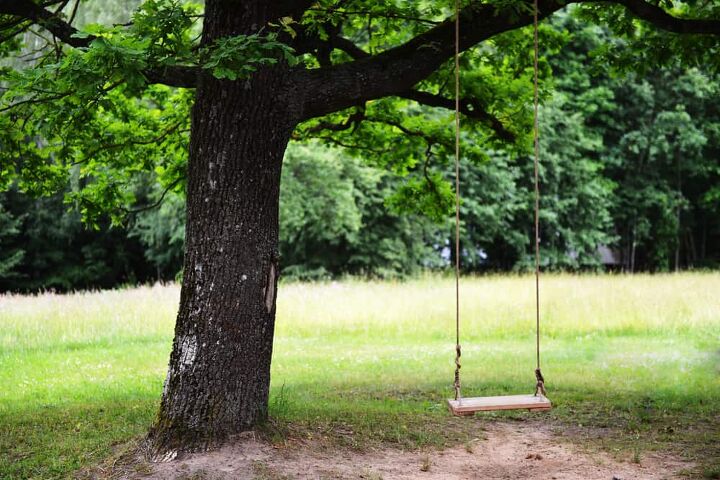How To Hang A Tree Swing On An Angled Branch (Do This!)

Trees swings are an excellent addition to homes for kids, as well as one of the most “ San Francisco” things you can add to a backyard. As long as you have a stable tree, you should be able to hang a tree swing with ease. Of course, most people have trees that have branches that sit parallel to the ground. What do you do, then, if you want to hang a swing on an angled branch?
To hang a tree swing on an angled branch, you will need to determine how much of a difference the higher point of the swing is from the lower part of the swing. When installing your swing, add the leeway to the rope holding the higher end of the swing. Tie the swing off, double-checking and adjusting to make sure it’s level.
Getting a tree swing is basically a must if you want to enjoy summer the old-fashioned way, but installing it correctly makes all the difference. We’re going to show you how to work with an angled branch.
Do You Need Handyman Services?
Get free, zero-commitment quotes from pro contractors near you.

Choosing The Right Branch
A swing is not going to be safe if you choose a branch that is too flimsy. Before you begin, make sure that the branch you want to install your swing on is at least eight inches in diameter on both parts of the branch holding your rope. Do not try to put a swing on a dead tree or a dead branch, because it’s more prone to snapping.
Once you have a good branch, you’re ready to hang a swing. Grab a swing of your choice.
Choosing The Right Rope
Believe it or not, rope type matters when you are going to install a swing. Regular twine obviously won’t be a good match. To get the best possible safety for your kids, we suggest using high-quality polyester (or polymer) rope that is designed to be used on swings and jungle gyms. If it’s not meant to handle human weight, don’t use it.
The most popular rope to choose for a tree swing is a manila rope that has a diameter of at least 3/4 inch. This usually has a weight load of 695 pounds and has that classic rope look that people love. If you want to get more of a weight load, then polyester is better. Polyester ropes can hold over 1,400 pounds!
How To Hang A Traditional Swing On An Angled Branch
Now that you have an appropriate swing branch, it’s time to actually hang the swing. With these directions, we’re giving you the safest way to hang a typical swing. Here’s what to do:
- Measure the width of your swing and then add four inches to that. Write that down for future reference. Locate a place on your branch that you want to install the swing.
- Drill a vertical hole through the tree at two points. The points should be the same distance from one another as the measurement you just took.
- Grab a level and take it up to the branch. Climb a ladder if you have to. Hold the level even against the lowest hole, then angle it so the level is totally even. Measure how far the top of the level is from the higher branch. Keep that measurement in mind, or write it down. This is your offset measurement.
- Cut a long piece of a 1-inch PVC pipe. The pipe should be an inch longer than the diameter of the branch, plus the additional offset. For example, if you have an eight-inch diameter and a four-inch offset, you should have a 13-inch pipe.
- Grab a 3/8 inch bit and drill across the pipe’s top 1/2 inch down. Get a long nut and bolt kit that fits and fastens with those dimensions.
- Drill out the higher portion of the tree branch with a 1-inch bit. Place the pipe underneath the hole and push it up through the top. The pipe should have holes at the top of the pipe, not at the bottom.
- Use the long nut and bolt kit to secure the pipe to the branch, leaving the offset dipping underneath the branch. This will help even out the swing.
- Feed one of the two ropes through the tube, and tie a huge knot there. Secure the nut and bolt across the top of the tube’s distance. This will help keep your ropes in check.
- Cut and tie a long rope on the other side of the tree. This will be on the lower side of the tree.
- Install your swing at the bottoms of both ropes and knot in place. Make sure to use a level to even out the knots so that you have a completely safe and level swingset.
How Often Should You Replace The Rope On A Traditional Tree Swing?
Believe it or not, ropes don’t last as long as you think they do on trees. To ensure the maximum safety against the elements and breakage, we suggest replacing the rope on a tree swing every two to three years. While many families don’t do this, it’s still better to be safe than sorry here. Hey, at least you don’t have to anchor this swing set, right?
Why Do You Need The PVC Pipe To Even Out The Swing?
Technically, you don’t have to have the PVC pipe even out the bend of the rope. There are plenty of old fogies like myself who lived with tree swings that were put on uneven branches that didn’t have one. However, there are risks to forgoing the pipe that many parents might not be aware of.
The biggest issue that you need to be aware of is that swinging on an uneven branch yields an uneven fulcrum. This means that the swing will naturally bend one way more than the other. At first, this doesn’t sound that bad. However, it can cause your kid (or yourself) to crash into things nearby or get tangled up in the rope.
Due to the increased concern about maximizing safety for children, we strongly suggest using the PVC pipe as a way to even out the fulcrum. This ensures that your swing will only go back and forth, rather than diagonally.
How To Hang A Tire Swing On An Angled Branch
Here’s one thing that you may want to consider when you are debating installing a swing: the traditional swing look you see as San Francisco’s “secret swings” takes a lot of work to do, and it can get a little confusing if you aren’t good with written instructions. If you want to get some swing fun but don’t want to do all that measuring and work, go for a tire swing.
A tire swing just requires you to tie the rope supporting the tire to the tree using a bowline knot. Then, secure the tire to the rope using a second bowline knot. Just like that, you’re done. No need for fulcrum pipes or anything else.
How Long Does It Take To Install A Tire Swing?
If you couldn’t guess from the instructions, installing a traditional swing is a full-day project. If you want to cut your work time, you can choose to install a tire swing instead. This is a simpler project that requires an average of half a day’s work, assuming that you will be working alone.
Do You Need Handyman Services?
Get free, zero-commitment quotes from pro contractors near you.

Related Questions
Are tree swings actually safe?
Tree swings have been a favorite backyard accessory for hundreds of years, even before amusement parks existed. They’ve been considered to be safe for centuries, but that safety is conditional. In order for a swing to be deemed safe, it has to be on a safe branch, using high-quality rope, and has to be installed properly.Most tree swings that you see are totally safe for use. When in doubt, get a closer look at the rope. If the rope looks worn and frayed, you should play it safe and avoid swinging on that particular swing.
How much does it cost to get a tree swing professionally installed?
Due to the amount of labor and materials that installing a tree swing can take, getting professional installers can be rough. If you are able to find niche installers for a tree swing, expect to pay between $350 to $1000 for a tree swing installation. This includes parts, installation, as well as any type of tree preparation that you need to have done.
Do tree swings hurt trees?
They can, especially if you have to drill through a branch in order to get the swing installed or if you install a particularly heavy tree. If you do not need to even out the fulcrum, you can reduce tree damage by choosing to wrap the swing around the branch rather than drill holes through the tree.The important thing to remember is that trees don’t really feel pain. It’s not like you’re causing it discomfort. Rather, you might put a little extra stress on their branches.
Related Guides

Ossiana Tepfenhart is an expert writer, focusing on interior design and general home tips. Writing is her life, and it's what she does best. Her interests include art and real estate investments.
More by Ossiana Tepfenhart










![10 Best Cordless Leaf Blowers – [2022 Reviews & Ultimate Guide]](https://cdn-fastly.upgradedhome.com/media/2023/07/31/9070789/10-best-cordless-leaf-blowers-2022-reviews-ultimate-guide.jpg?size=350x220)


![10 Best Electric Pressure Washers – [2022 Reviews & Guide]](https://cdn-fastly.upgradedhome.com/media/2023/07/31/9070600/10-best-electric-pressure-washers-2022-reviews-guide.jpg?size=350x220)
![10 Best Zero Turn Mowers – [2022 Reviews & Ultimate Buyer's Guide]](https://cdn-fastly.upgradedhome.com/media/2023/07/31/9070522/10-best-zero-turn-mowers-2022-reviews-ultimate-buyer-s-guide.jpg?size=350x220)






![Cost To Drill A Well [Pricing Per Foot & Cost By State]](https://cdn-fastly.upgradedhome.com/media/2023/07/31/9074980/cost-to-drill-a-well-pricing-per-foot-cost-by-state.jpg?size=350x220)





